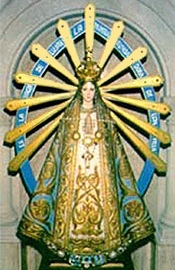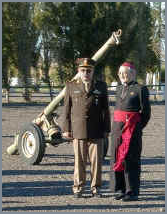%%rimage[Concordat's Military Bishop shocks Argentina, President threatens to end Vatican pact]=X11781_727_ARVirgenLujanlogo_t55.jpg Concordat's Military Bishop shocks Argentina, President threatens to end Vatican pact
In 2005 the Argentine military bishop attacked AIDS prevention by the democratic government, while appearing to make light of the death squads of the former military junta. This revealing remark has made it politically possible for President Nestor Kirchner to threaten to cancel a concordat — the “international treaty” which let the Vatican appoint this military bishop — although it is the taxpayers who provide the bishop’s salary.
 The Virgin Mary is the patron saint of Argentina — and also of its military who tried, though her, to pose as the protectors of the nation. General Juan Carlos Onganía who abolished democracy and immediately signed a concordat, consecrated the nation to the immaculate heart of Mary. In November 1969, surrounded by two thousand body guards, he led civilian and military authorities to the Marian shrine of Luján where he appointed the Virgin to be a general in the Chilean army. [1]
The Virgin Mary is the patron saint of Argentina — and also of its military who tried, though her, to pose as the protectors of the nation. General Juan Carlos Onganía who abolished democracy and immediately signed a concordat, consecrated the nation to the immaculate heart of Mary. In November 1969, surrounded by two thousand body guards, he led civilian and military authorities to the Marian shrine of Luján where he appointed the Virgin to be a general in the Chilean army. [1]
This public veneration was continued by the generals who assumed power in a coup d’état seven years later. They mixed it with a violent, rightwing military cult which has been called the Theology of Death. [2] From 1976 to 1983 the junta subjected Argentina to seven years of terror, a nightmare known as the Dirty War. Tens of thousands of people were “disappeared” by the police and the military, that is to say, were abducted, tortured and secretly executed. One method was through “death flights”. The victims were loaded into military aircraft, often (but not always) drugged unconscious and dropped alive into the sea. [3] Sometimes their stomachs were slit open first, to make them sink more rapidly and to attract sharks who would destroy the evidence. [4] Even so, some of the bodies survived to be washed up on shore. Photos of these bodies have been recently released. One was even well enough preserved to show evidence of torture and rape. [5]
The rule of the junta ended in 1983, but it wasn’t until twenty years later that President Nestor Kirchner took office and shortly afterwards suspended the immunity enjoyed by former military leaders. His democratic, left-of-centre government has also reformed the Supreme Court, making it more politically independent and better able to come to terms with the country's past.
However, it was his government’s campaign to reduce AIDS that led to the concordat crisis. In February 2005 when the Health Minister and medical doctor Gines Gonzalez Garcia approved the distribution of free condoms to young people Military Bishop Antonio Juan Baseotto felt moved to declare that “those who scandalise little ones should have a stone tied around their neck and be thrown into the sea”. [6] The Bishop claimed, of course, that he was merely quoting the loving words of Christ (Mark 9:42).
 Even so, many Argentines were not convinced. In particular, the remarks of the military bishop were not appreciated by the Mothers of the Plaza de Mayo. These are the women who defied the junta by demonstrating every week in the plaza, seeking information about their children who had disappeared into the torture chambers and the sea. “The Mothers’ use of the imagery of Christian motherhood made them particularly effective against the professedly Catholic military regime.” [7] it was clear that these mothers grieving over their dead children better represented the image of the Virgin than the military men who claimed her as their patron.
Even so, many Argentines were not convinced. In particular, the remarks of the military bishop were not appreciated by the Mothers of the Plaza de Mayo. These are the women who defied the junta by demonstrating every week in the plaza, seeking information about their children who had disappeared into the torture chambers and the sea. “The Mothers’ use of the imagery of Christian motherhood made them particularly effective against the professedly Catholic military regime.” [7] it was clear that these mothers grieving over their dead children better represented the image of the Virgin than the military men who claimed her as their patron.
It was also clear where the Military Bishop’s sympathies lay. The Minister of Health publicly charged Bishop Baseotto with “well-oiled links with the last military dictatorship”. [8] (He is seen here on his March 2004 “pastoral visit” to the 9th Mechanised Brigade.) [9] And this, of course, this was the Bishop who excused the junta’s use of torture and murder as “excesses that are impossible to avoid in a war.” [10]
 But the scandal resonated well beyond Argentina, since Bishop Baseotto is no ordinary prelate. Under the terms of a concordat signed with the Vatican, Argentina agreed to the establishment of a military chaplaincy and Baseotto is the Bishop responsible for this. Furthermore, his salary is paid by the state. In February 2005 President Kirchner asked the Vatican to replace the Military Bishop, but three weeks later his request was refused. On 18 March 2005 President Kirchner issued two decrees. The first withdrew his support for the 1992 concordat by which the Vatican had appointed the military bishop and the second one cancelled public funding for the Bishop's chaplaincy, including his salary.
But the scandal resonated well beyond Argentina, since Bishop Baseotto is no ordinary prelate. Under the terms of a concordat signed with the Vatican, Argentina agreed to the establishment of a military chaplaincy and Baseotto is the Bishop responsible for this. Furthermore, his salary is paid by the state. In February 2005 President Kirchner asked the Vatican to replace the Military Bishop, but three weeks later his request was refused. On 18 March 2005 President Kirchner issued two decrees. The first withdrew his support for the 1992 concordat by which the Vatican had appointed the military bishop and the second one cancelled public funding for the Bishop's chaplaincy, including his salary.
The Vatican then protested that this was an attack on “religious freedom” and even a violation of “international law”. [11] For when the Vatican signed the concordat to establish the military chaplaincy, it did so as “the Holy See”, the name it uses when it claims to be a country. This removed the accord from democratic control and made set the rules for the chaplaincy in stone. The Argentine Parliament had no further say in the matter once it was bound by a concordat or “international treaty”, for international law has priority over national legislation.
This means that technically firing the military bishop violates an international treaty. However, in reality, it is matter of a make-believe treaty with a make-believe state. No one seemed too worried about an imminent attack on Buenos Aires by helmeted Swiss Guards brandishing swords and pikes. Kirchner’s rejection of the concordat shows how easy it can be if the political will is there. All it took was a presidential decree — and the strength to brave a Vatican tirade.
Notes
1. Linda B. Hall, Mary, Mother and Warrior: The Virgin in Spain and the Americas, University of Texas Press, 2004, p. 239
2. Rubén Dri, “The Theology of Death”, Pagina 12, 28 December 2010. http://www.pagina12.com.ar/diario/elpais/1-159425-2010-12-28.html Translation at
http://elblogdelpelon.wordpress.com/2012/04/18/the-theology-of-death/
3. Paul Gray, “A former naval officer confesses to throwing prisoners into the ocean during the dirty war”, Time, Volume 145, No. 13, 27 March 1995. http://www.yendor.com/vanished/junta/scilingo.html
4. “Another torturer reveals horrors of the Dirty War in Argentina”, translation of “Otro torturador revela horrores de la guerra sucia en Argentina”, La Jornada, Mexico, 2 July 1995. http://www.yendor.com/vanished/junta/caraballo.html
5. “Photos of missing people from the ‘death flights’ come to light”, M24 Digital, 15 December 2011. http://m24digital.com/en/2011/12/15/photos-of-missing-people-from-the-death-flights-come-to-light/
6. “Argentinean government withdraws recognition of bishop”, Catholic News Agency, 21 March 2005. http://www.catholicnewsagency.com/new.php?n=3408
7. “The Mothers of Plaza de Mayo”, The Vanished Gallery. http://www.yendor.com/vanished/madres.html
8. “Argentina: Despite Vatican, President Sacks Controversial Military Bishop” Inter Press Service News Agency, 18 March 2005. http://ipsnews.net/news.asp?idnews=27933
9. “Visita Pastoral en el ámbito de la IXna Brigada Mecanizada”, 8-12 March 2004. http://www.vtocuerpo.ejercito.mil.ar/noticias_mar2004.htm
10. “Argentina: Despite Vatican, President Sacks Controversial Military Bishop” Inter Press Service News Agency, 18 March 2005. http://ipsnews.net/news.asp?idnews=27933
11. “Argentina, Vatican clash on bishop's dismissal”, Catholic World News, 21 March 2005. http://www.cwnews.com/news/viewstory.cfm?recnum=35986







